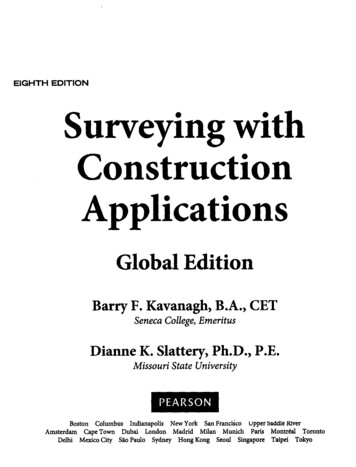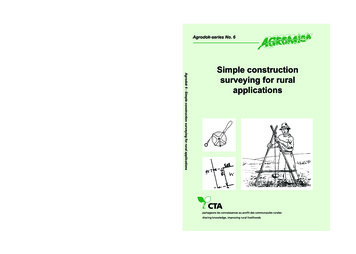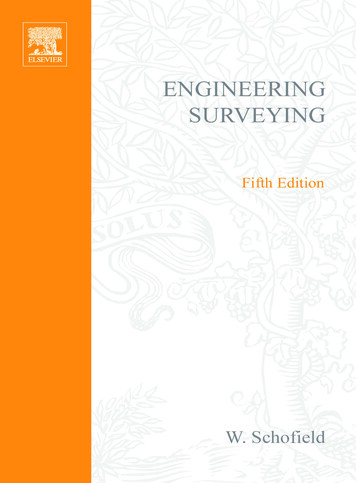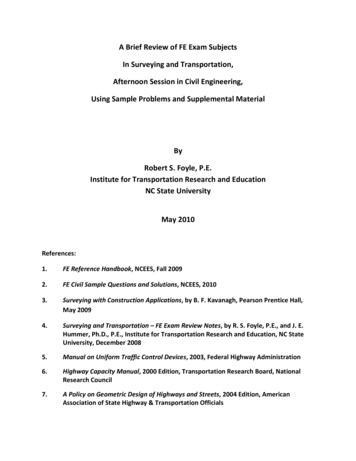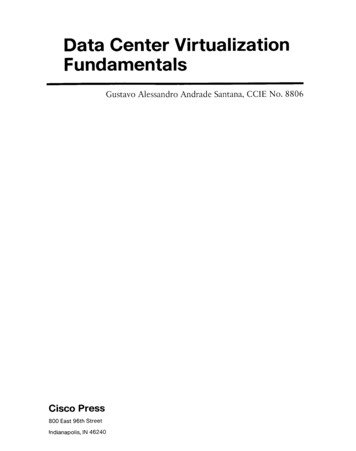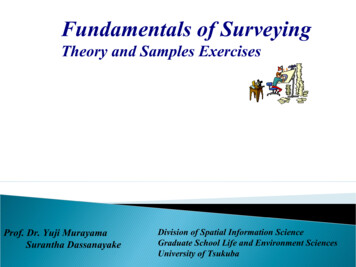
Transcription
Fundamentals of SurveyingTheory and Samples ExercisesProf. Dr. Yuji MurayamaSurantha DassanayakeDivision of Spatial Information ScienceGraduate School Life and Environment SciencesUniversity of Tsukuba
Definition of Surveying Surveying has to do with the determination of the relative spatial location of points on or nearthe surface of the earth.It is the art of measuring horizontal and vertical distances between objects, of measuringangles between lines, of determining the direction of lines, and of establishing points bypredetermined angular and linear measurements.Along with the actual survey measurements are the mathematical calculations.Distances, angles, directions, locations, elevations, areas, and volumes are thus determinedfrom the data of the survey.Survey data is portrayed graphically by the construction of maps, profiles, cross sections, anddiagrams.The importance of the SurveyingLand surveying is basically an art and science of mapping and measuring land. The entirescope of profession is wide; it actually boils down to calculate where the land boundaries aresituated. This is very important as without this service, there would not have been railroads,skyscrapers could not have been erected and neither any individual could have put fencesaround their yards for not intruding others land.2
Types of SurveyingGeodetic Surveying:The type of surveying that takes into account the true shape of theearth. These surveys are of high precision and extend over largeareas.Plane Surveying:The type of surveying in which the mean surface of the earthis considered as a plane, or in which its spheroidal shape isneglected, with regard to horizontal distances and directions.3
Different methods of Surveying Control Survey: Made to establish the horizontal and vertical positions of arbitrary points.Boundary Survey: Made to determine the length and direction of land lines and to establishthe position of these lines on the ground.Topographic Survey: Made to gather data to produce a topographic map showing theconfiguration of the terrain and the location of natural and man-made objects.Hydrographic Survey: The survey of bodies of water made for the purpose of navigation,water supply, or sub-aqueous construction.Mining Survey: Made to control, locate and map underground and surface works related tomining operations.Construction Survey: Made to lay out, locate and monitor public and private engineeringworks.Route Survey: Refers to those control, topographic, and construction surveys necessary forthe location and construction of highways, railroads, canals, transmission lines, andpipelines.Photogrammetric Survey: Made to utilize the principles of aerial photogrammetry, in whichmeasurements made on photographs are used to determine the positions of photographedobjects.Astronomical survey: generally involve imaging or "mapping" of regions of the sky usingtelescopes.4
Basic Trigonometry functions forDistance and Angular MeasurementsPythagorean TheoremIn a right triangle, the square of the hypotenuse isequal to the sum of the squares of the other two sides.C 2 A2 B2where: C is the hypotenuse (side opposite the rightangle). A and B are the remaining sides.Units of Angular MeasurementThe most common angular units being employedin the United States is the Sexagesimal System.This system uses angular notation in incrementsof 60 by dividing the circle into 360 degrees;degrees into 60 minutes; and minutes into 60seconds.Therefore;1 circle 360 21,600 1,296,000 1 60 3600 1 60 5
Most useable functions of TrigonometryAll trigonometric functions are simply ratios of one side of a right triangle to a second side ofthe same triangle, or one side over another side. The distinction between functions is whichtwo sides are compared in the ratio.The figure below illustrates the side opposite from and the side adjacent to Angle A, and thehypotenuse (the side opposite the right angle). The trigonometric functions of any angle are bydefinition:Sine A Opposite Side / Hypotenusecosine A Adjacent Side / HypotenuseTangent A Opposite Side / Adjacent Sideand inverting each ratio, we havecosecant Hypotenuse / Opposite Side 1/sine Asecant Hypotenuse / Adjacent Side 1/cosine Acotangent Adjacent Side / Opposite Side 1/tangent A6
Algebraic Signs of the Trigonometric Functions in each QuadrantUsing the definitions on the previous page, we can determine the values of the functions for eachangle shown below. List the Sine, Cosine, and Tangent of each angle in both fractional anddecimal form.Quadrat 1Tanθ 3/4 0.7500Quadrat 2Sin 180-θ 3/5 0.6000Cos 180-θ -4/5 -0.8000Tan 180-θ 3/-4 -0.7500Quadrat 3Sin 180 θ -3/5 -0.6000Cos 180 θ -4/5 -0.8000Tan 180 θ -3/-4 0.7500Quadrat 4Sin 360-θ -3/5 -0.6000Cos 360-θ 4/5 0.8000Tan 360-θ -3/4 -0.75007
Distance Measuring (Chaining surveying)English mathematician Edmund Gunter (1581-1626) gaveto the world not only the words cosine and cotangent, andthe discovery of magnetic variation, but the measuringdevice called the Gunter’s chain shown below. Edmundalso gave us the acre which is 10 square chains.The Gunter’s chain is 1/80th of a mile or 66 feet long. It iscomposed of 100 links, with a link being 0.66 feet or 7.92inches long. Each link is a steel rod bent into a tight loop oneach end and connected to the next link with a small steelring.Starting in the early 1900’s surveyors started using steeltapes to measure distances. These devices are still called“chains” to this day.8
Procedure of Chaining It must be remembered in surveying, that under most circumstances, all distances are presumed tobe horizontal distances and not surface distances. This dictates that every field measurement taken be either measured horizontally or, if not, reducedto a horizontal distance mathematically. In many instances, it is easiest to simply measure the horizontal distance by keeping both ends ofthe chain at the same elevation. This is not difficult if there is less than five feet or so of elevationchange between points. A hand level or “pea gun” is very helpful for maintaining the horizontalposition of the chain when “level chaining.” A pointed weight on the end of a string called a“plumb bob” is used to carry the location of the point on the ground up to the elevated chain bysimply suspending the plumb bob from the chain such that the point of the plumb bob hangs directlyabove the point on the ground. When the difference in elevation along the measurement becomes too great for level chaining, othermethods are called for. One option, “break chaining”, involves simply breaking the measurementinto two or more measurements that can be chained level.9
Distance Measuring (Electronic Distance Meters)In the early 1950’s the first Electronic Distance Measuring (EDM) equipment were developed.These primarily consisted of electro-optical (light waves) and electromagnetic (microwave)instruments. They were bulky, heavy and expensive. The typical EDM today uses the electro-opticalprinciple. They are small, reasonably light weight, highly accurate, but still expensive.Principle of Chaining To measure any distance, you simply compare it to aknown or calibrated distance; for example by usinga scale or tape to measure the length of an object.In EDM’s the same comparison principle is used.The calibrated distance, in this case, is the wavelengthof the modulation on a carrier wave.Modern EDM’s use the precision of a Quartz Crystal Oscillator and the measurement of phase-shiftto determine the distance.The EDM is set up at one end of the distance to be measured and a reflector at the other end.The EDM generates an infrared continuous-wave carrier beam, which is modulated by an electronicshutter (Quartz crystal oscillator).This beam is then transmitted through the aiming optics to the reflector.The reflector returns the beam to the receiving optics, where the incoming light is converted to anelectrical signal, allowing a phase comparison between transmitted and received signals.The amount by which the transmitted and received wavelengths are out of phase, can be measuredelectronically and registered on a meter to within a millimeter or two.10
Angle MeasuringMeasuring distances alone in surveying does not establish the location of an object. Weneed to locate the object in 3 dimensions. To accomplish that we need:1. Horizontal length (distance)2. Difference in height (elevation)3. Angular direction.An angle is defined as the difference in direction between two convergent lines. Ahorizontal angle is formed by the directions to two objects in a horizontal plane. Avertical angle is formed by two intersecting lines in a vertical plane, one of these lineshorizontal. A zenith angle is the complementary angle to the vertical angle and isformed by two intersecting lines in a vertical plane, one of these lines directed towardthe zenith.11
Types of Measured Angles Interior angles are measured clockwise or counter-clockwise between two adjacentlines on the inside of a closed polygon figure. Exterior angles are measured clockwise or counter-clockwise between two adjacentlines on the outside of a closed polygon figure. Deflection angles, right or left, are measured from an extension of the precedingcourse and the ahead line. It must be noted when the deflection is right (R) or left (L).12
A Theodolite is a precision surveying instrument; consisting of analidade with a telescope and an accurately graduated circle; andequipped with the necessary levels and optical-reading circles. Theglass horizontal and vertical circles, optical-reading system, and allmechanical parts are enclosed in an alidade section along with 3leveling screws contained in a detachable base or tribrach.A Transit is a surveying instrument having a horizontal circledivided into degrees, minutes, and seconds. It has a vertical circleor arc. Transits are used to measure horizontal and vertical angles.The graduated circles (plates) are on the outside of the instrumentand angles have to be read by using a vernier.13
Bearings and AzimuthsThe Relative directions of lines connecting survey points may be obtained in a variety of ways. Thefigure below on the left shows lines intersecting at a point. The direction of any line with respect toan adjacent line is given by the horizontal angle between the 2 lines and the direction of rotation.The figure on the right shows the same system of lines but with all the angles measured from a lineof reference (O-M). The direction of any line with respect to the line of reference is given by theangle between the lines and its direction of rotation.14
The line of reference (Meridian)There are several types of meridians: Astronomical or True, Magnetic, Grid, and Assumed .Astronomical or True MeridiansA plane passing through a point on the surface of the earth and containingthe earth’s axis of rotation defines the astronomical or true meridian at thatpoint. Astronomical meridians are determined by observing the position ofthe sun or a star. For a given point on the earth, its direction is always thesame and therefore directions referred to the astronomical or true meridianremain unchanged. This makes it a good line of reference.Astronomical or true meridians on the surface of the earth are lines ofgeographic longitude and they converge toward each other at the poles. Theamount of convergence between meridians depends on the distance from theequator and the longitude between the meridians.Magnetic MeridianA magnetic meridian lies parallel with the magnetic lines of force of theearth. The earth acts very much like a bar magnet with a north magneticpole located considerably south of the north pole defined by the earth’srotational axis. The magnetic pole is not fixed in position, but ratherchanges its position continually. The direction of a magnetized needledefines the magnetic meridian at that point at that time. Because themagnetic meridian changes as magnetic north changes, magneticmeridians do not make good lines of reference.15
Grid MeridiansIn plane surveys it is convenient to perform the work in a rectangularXY coordinate system in which one central meridian coincides with atrue meridian. All remaining meridians are parallel to this central truemeridian. This eliminates the need to calculate the convergence ofmeridians when determining positions of points in the system. Themethods of plane surveying, assume that all measurements are projectedto a horizontal plane and that all meridians are parallel straight lines.These are known as grid meridians.The Oregon Coordinate System is a grid system.Assumed MeridiansOn certain types of localized surveying, it may not be necessary to establish a true, magnetic, or grid direction.However it is usually desirable to have some basis for establishing relative directions within the current survey.This may be done by establishing an assumed meridian.An assumed meridian is an arbitrary direction assigned to some line in the survey from which all other lines arereferenced. This could be a line between two property monuments, the centerline of a tangent piece of roadway, oreven the line between two points set for that purpose.The important point to remember about assumed meridians is that they have no relationship to any other meridianand thus the survey cannot be readily (if at all) related to other surveysAzimuthsThe azimuth of a line on the ground is its horizontal angle measured from the meridian to the line. Azimuth givesthe direction of the line with respect to the meridian. It is usually measured in a clockwise direction with respectto either the north meridian or the south meridian. In plane surveying, azimuths are generally measured from thenorth.When using azimuths, one needs to designate whether the azimuth is from the north or the south.Azimuths are called true (astronomical) azimuths, magnetic azimuths
2 Surveying has to do with the determination of the relative spatial location of points on or near the surface of the earth. It is the art of measuring horizontal and vertical distances between objects, of measuring angles between lines, of determining the direction of lines, and of establishing points by predetermined angular and linear measurements.
